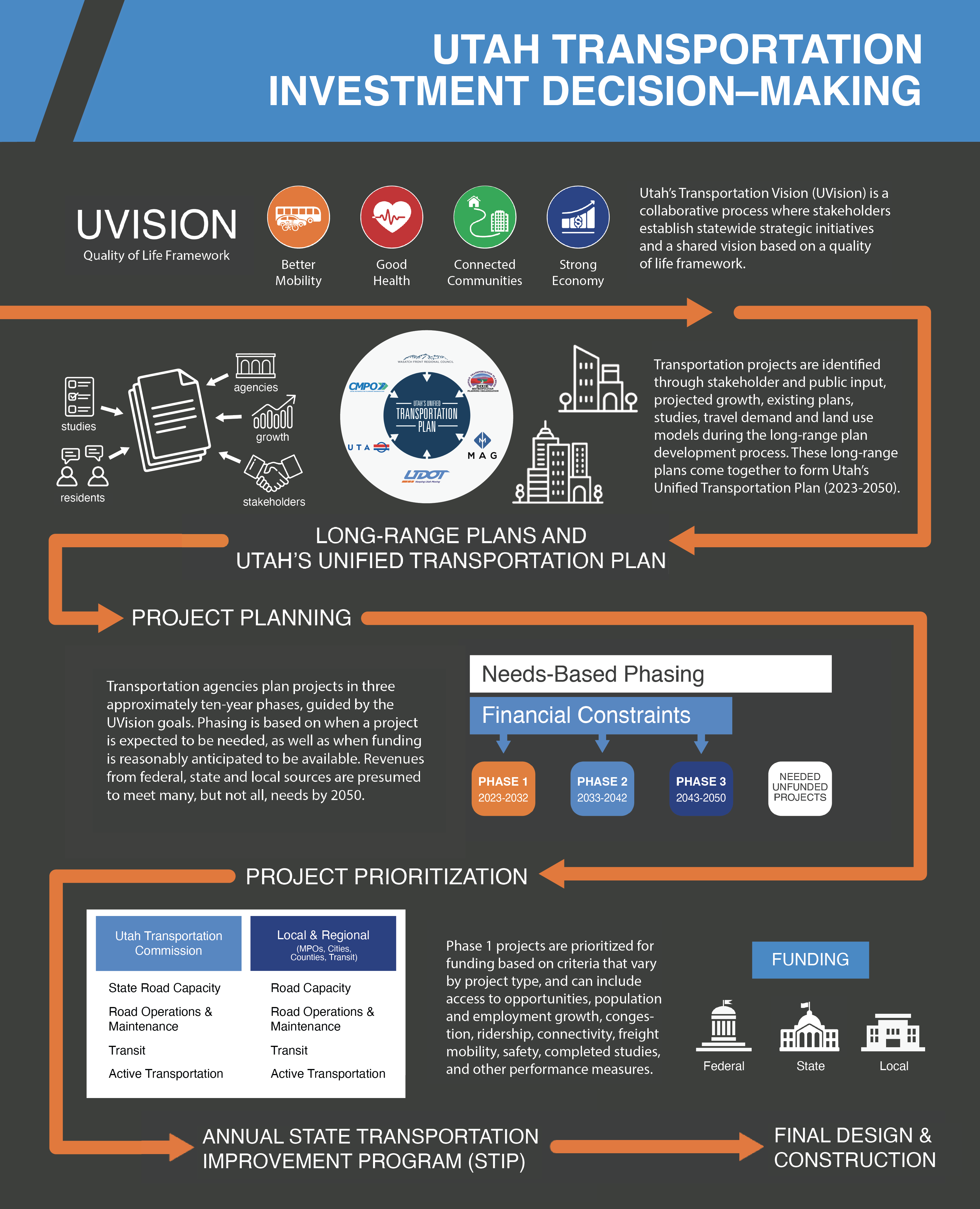Utah is one of the fastest-growing states in the nation. That growth means more transportation demands on our roads, transit, and trails. More people means more goods and services to be delivered, more employees commuting to work, and more errands to run. To keep people connected and commerce moving requires an integrated, multimodal transportation system where Utahns have real transportation choices. And that transportation system needs to be operated and maintained in a safe and good condition.
Utah’s Unified Transportation Plan identifies the priority statewide transportation needs from now until 2050. It plans for expanded capacity to meet Utah’s growth with new bike and pedestrian paths; increased frequency of transit service and new transit options via bus and rail; and new or upgraded state and local roads. It also accounts for the investments needed to operate and maintain our transportation system safely and in good condition.
The planning starts with the Utah Transportation Vision Quality of Life framework, based on the goals of better mobility, good health, connected communities, and a strong economy. This Vision recognizes Utah’s growth challenges and the relationship between transportation, housing, air quality and the environment, land use, economic development, and access to opportunities for all.
The Utah Department of Transportation (UDOT), Utah Transit Authority (UTA), and metropolitan planning organizations (MPOs) Cache MPO, Dixie MPO, Mountainland Association of Governments (MAG), and Wasatch Front Regional Council (WFRC), all collaborate in the development of Utah’s Unified Transportation Plan, with the input of cities and counties, legislators, business and community organizations, other stakeholders, and the public.
Needed transportation projects are identified by projecting future growth and development patterns and then modeling travel demand. The performance of the current transportation system is evaluated, and enhancements to that system are considered to meet current and future demand. The transportation system can perform better when there are choices for how people can get around, and when land use and transportation are effectively coordinated, such as through the Wasatch Choice Vision.
The planning process identifies the most effective projects, and sorts them into three roughly 10-year phases based on when they are anticipated to be needed. The timing of projects is further refined based on the anticipated availability of revenue.
Part of the annual funding in Utah’s Unified Transportation Plan goes toward maintenance to enhance the longevity and safety of Utah’s multimodal transportation system. Keeping infrastructure in good condition through consistent maintenance saves money in the future.
Utah’s transportation agencies work together to develop projections of available funding for the duration of Utah’s Unified Transportation Plan. Because resources are limited, not all transportation needs can be met. The Plan is financially constrained – it does not assume resources are unlimited and only plans based on revenues reasonably projected to be available – so as to be fiscally prudent and meet critical transportation needs.
Funding sources for transportation include user fees, such as state and federal motor fuel taxes and state and local vehicle registration fees; state and local sales taxes; federal, state and local discretionary or general funds; and other sources.
Projects included in Phase 1 (2023-2032) of Utah’s Unified Transportation Plan are eligible to be prioritized to be funded. The prioritization process differs somewhat depending on the type of projects and the entities.
For state road projects that increase highway capacity, the Utah Transportation Commission, in consultation with UDOT and the MPOs, develops and uses a Prioritization Process for funding transportation capacity projects. Processes are also used for state transit and trail projects. Phase 1 projects from Utah’s Unified Transportation Plan are run through a weighted criteria system to produce a ranked list of those projects (there is also a mechanism for projects to be nominated for consideration). The weighted criteria system is built around the Utah Transportation Vision Quality of Life framework. The ranked list of projects is used by the Utah Transportation Commission as a decision support tool in deciding which projects to fund, and when. Prior to finalizing priorities and funding levels of projects, the Utah Transportation Commission accepts public comments.
For other UDOT project types such as pavement and/or bridge reconstruction, rehabilitation, and preservation, UDOT uses condition-based measures, projections, and targets to develop funding-level recommendations that are presented and approved by the Utah Transportation Commission during their public meetings.
UTA and other transit agencies invest their funds to operate trains and buses, to make capital investments to expand transit service, and to maintain their vehicles, tracks, and other infrastructure in good condition, based on projected ridership, asset condition, expected lifespan, and other factors.
Utilizing a data-driven, performance-based, transparent process allows needs to be carefully assessed and the most effective approaches and solutions to be identified. This helps to assure policymakers and the public that funds are being used carefully and prudently.
Implementing Utah’s Unified Transportation Plan will help Utah to stay ahead of future growth and take care of our infrastructure investments. It will result in significant benefits for Utah including reducing emissions and improving air quality; mitigating traffic congestion and saving driving time; increasing jobs and GDP; increasing access to opportunities; and improving overall quality of life.

